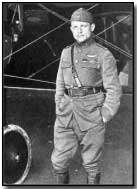Who's Who - Raoul Lufbery
 Gervaise Raoul Lufbery
(1885-1918), the high scoring U.S.
air ace of
World War One, actually served in both French and U.S. Air Services between
1914-18.
Gervaise Raoul Lufbery
(1885-1918), the high scoring U.S.
air ace of
World War One, actually served in both French and U.S. Air Services between
1914-18.
Lufbery was born on 14 March 1885 in Clermont-Ferrand in France. Although his family emigrated to the U.S. while he was just six years old, and Lufbery regarded himself as American, he spoke better French than English.
In fact Lufbery only arrived in the U.S. when he was 19 years old, where his father had established a stamp dealership in Connecticut. Lufbery himself worked in a chocolate factory in Blois and Clermont-Ferrand until 1904 when he determined to see something of the world, travelling variously to Germany, Turkey, the Balkans and North Africa before spending some time in England making silver casket handles. His wanderlust not yet satisfied he further travelled to Cuba, New Orleans (the latter occupied as a baker) and San Francisco (as a waiter).
Deciding upon a career in the U.S. Army he went on to serve in the Philippines; he was to develop especial expertise in marksmanship. During this period also he became a U.S. citizen. Having left the army Lufbery next headed for the far east.
In Calcutta in 1912 he met the renowned French airman Marc Pourpe, forged a friendship and agreed to become the latter's mechanic, thereafter travelling the globe together, to Europe and Africa. Lufbery was with Pourpe when the latter made the first Cairo to Khartoum round-trip by air.
The arrival of war in August 1914 saw Lufbery determined to play a part in the Allied cause. With the U.S. neutral until April 1917 he enlisted with the French Foreign Legion while Pourpe joined the nascent French Air Service. Lufbery planned to apply for a transfer to the French Air Service in order that he could continue as Pourpe's mechanic; in the event Pourpe was killed while landing in fog at night on 2 December 1914.
Lufbery determined to learn how to fly and successfully enlisted with Escadrille V.B. 106 in October 1915 although his Nieuport training continued until the following May. He was assigned to Escadrille Americaine on 24 May 1916 and achieved his first official 'kill' on 30 July 1916 in the skies above Verdun, bringing down a German two-seater aircraft; he was to score his second success later the same day.
Although not regarded as a natural pilot he rapidly achieved 'ace' status - five kills, the first U.S. citizen to achieve the award - and went on to earn the Medaille Militaire, Croix de Guerre and Légion d'Honneur, eventually achieving an official tally of 17 air successes.
American entry into the war brought Lufbery a reassignment to the U.S. Air Service where he was widely revered for his remarkable achievements to date. In January 1918 he was sent to the Pursuit Organisation Center at Villeneuve-les-Vertus. Lufbery was subsequently reassigned to the U.S. 95th Aero Pursuit Squadron and then the 94th as a combat instructor.
He met his death on 19 May 1918 when, fighting a German Rumpler aircraft, his guns jammed prior to his aircraft bursting into flames. Lufbery was seen to fall upside down from the aircraft 200 feet from the ground, possibly from jumping. Landing on a picket fence in Maron, France and impaled Lufbery was dead aged 33. His remains were later moved to Lafayette Memorial du Parc de Garches in Paris.
A "box barrage" was an artillery bombardment centred upon a small area.
- Did you know?
